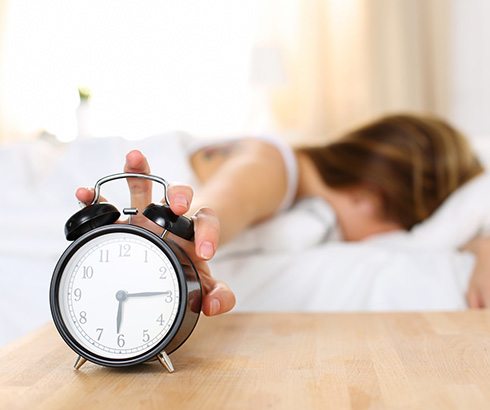QuietNite Laser Therapy – Portland, OR
Breathe Easier and Sleep Better
Does your partner often complain that you snore? Do you frequently wake up feeling exhausted? It is possible that you are not breathing properly at night. Our team is ready to help residents of the Portland community to deal with such issues. We offer multiple therapies that are designed to help patients achieve the rejuvenating, quiet rest they deserve. One of those options is known as DEKA QuietNite laser therapy. Read on below to learn more about this remarkable technology.
What Is DEKA QuietNite Laser Therapy?
Often, people snore and experience symptoms of obstructive sleep apnea (OSA) because the soft tissues in their upper airway have become flaccid and weak. Those tissues may vibrate and cause loud noise as air brushes past them. Sometimes, they may completely block the airway and lead to pauses in breathing (called apneas).
DEKA QuietNite laser therapy uses a CO2 laser to tighten flaccid tissues, encourage collagen production, and create a wider airway. It thereby allows patients to enjoy quieter, more rejuvenating rest.
How Does QuietNite Laser Therapy Work?

During QuietNite laser therapy, we apply a CO2 laser to loose tissues in the upper airway. The process is quick (a single session may take around 10 minutes) and comfortable. You might feel a warming sensation, and you might experience a sort of “popping” feeling, almost as if you were eating Pop Rocks Candy. No downtime is required after a QuietNite treatment, and you will be able to resume your normal eating and drinking habits right away.
Most patients notice a marked improvement in the quality of their sleep within just a few days of their initial laser therapy session.
For optimum results, we may recommend that you return for multiple sessions spaced 21 – 28 days apart. Depending on the severity of your condition, you might need to visit us 3 – 4 times. After you initial course of QuietNite treatment, you may have to return for annual maintenance so you can continue to enjoy high-quality sleep.
It is also worth noting that DEKA QuietNite laser therapy may be used as a standalone treatment. In some cases, though, it is most effective when it is combined with other services that are designed to provide relief from snoring and disordered breathing.
Who Is a Candidate for QuietNite Laser Therapy?

The best way to find out if DEKA QuietNite treatment is right for you is to schedule a consultation with our team. We will learn about your symptoms and perform an examination. If the situation calls for it, we may refer you for a formal sleep test, which will reveal whether you have a sleep disorder. Thereafter, we will be able to recommend your next steps.
Generally speaking, candidates for QuietNite laser therapy:
- Are known to snore regularly
- Exhibit symptoms of obstructive sleep apnea
- Want a minimally invasive way to achieve improved sleep quality
Airway Management FAQs
What Are the Dangers of Breathing and Respiration Being Out of Alignment?
When breathing and respiration are not working as they should, it may lead to a shift in your body chemistry. As a result, you might experience a number of symptoms, including:
- Nausea, vomiting, cramping and bloating in your abdominal area.
- Both acute and chronic fatigue.
- Heart problems, possibly including palpitations.
- Cognitive problems, which may include attention deficit disorders, learning challenges, poor memory, brain fog, and more.
- Poor emotional health. This could be marked by feelings of anxiety, anger, fear, and panic.
- Dizziness, fainting, and a reduction in balance and coordination.
- Muscle pains.
- Low performance at work due to sleep apnea, anxiety, and fatigue.
- Respiratory problems, including shortness of breath, airway resistance, and asthma-like symptoms
- Changes in sensory reactions. This might include changes in vision, dry mouth, and the feeling of sensory overload.
How Does Airway Management Treat Sleep Disorders?
Airway dentistry helps your upper airway to work in harmony with the rest of your body. It encourages the free exchange of vital gases and promotes healthy blood oxygen levels. These benefits can be especially noticeable at night.
For example, obstructive sleep apnea is a disorder where tissues in the throat block the flow of air. Airway dentistry can reduce or even completely eliminate such obstructions, leading to higher-quality sleep. Your partner may also notice that you do not snore as much as you previously did.
When Should Someone Avoid Airway Management Treatment?
When you visit us for a consultation, Dr. Teasdale and our team can let you know whether our airway management services are right for you. First, we will carefully evaluate the positioning of your teeth, jaws, and other aspects of your upper airway. Dr. Teasdale will then provide a professional opinion on what your next steps should be.
If our airway management services may not be suitable for you, we may encourage you to seek treatment from another type of specialist. For example, some patients require surgical intervention to achieve optimum airway improvements.
Additionally, some patients with certain types of airway trauma, or who cannot open their mouth enough for airway access, may not currently be candidates for airway management.
Are There Any Potential Complications to Airway Management?
When airway management services are provided by a qualified practitioner, the level of risk is very low. Dr. Teasdale is an expert in how the upper airway works, and he uses non-invasive, non-pharmaceutical approaches to care that have an impressive track record of success.
Of course, surgical approaches to airway management are a bit riskier. For example, there is a chance of infection. If you require surgery, your care provider can discuss such considerations with you so you can make a well-informed decision about how to move forward.
